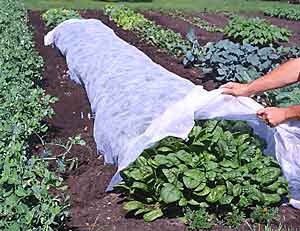Extending the Gardening Season
Plant seeds of long-season crops indoors in pots before the last frost date in your area. Start tomatoes, peppers, and eggplants 8 weeks early, cole crops about 4 to 6 weeks early, and vine crops 1 week early. Extend your harvest into fall by planting second crops of short-season vegetables, such as snap beans, peas, greens, radishes, cole crops, and turnips later in the season so they mature after you harvest the first crop.
Whether you live in Toronto, where the frost-free vegetable growing season is under 200 days long, or in Southern California, where it's over 300 days long, sometimes the season seems just too short. When this is the case, you can use the following methods to stretch extra days and weeks out of your growing season.
Tools and Materials
- Seed starting supplies
- Black, white, or clear plastic sheeting
- Row cover fabric and supports
- Organic mulch, such as grass clippings
Take advantage of micro climates. Some areas around your property warm up faster in the spring, stay cooler or warmer in the summer, or are protected from the wind. Use these protected sites to grow vegetables earlier or later in the season. Grow an extra early crop of cold-hardy spinach or lettuce, for example, on the sunny south side of a building.
Alter the soil temperature. In cold climates, use black plastic mulch to warm the soil in spring and retain extra heat in fall. In hot climates, use reflective white plastic to keep the soil cooler. Cover the edges of the plastic with soil to anchor it in place. Organic mulches such as grass clippings also moderate soil temperature, preventing hot and cold extremes.
Protect from early and late frost. In spring and fall, freezing temperatures limit plant growth in northern latitudes (southern if you live south of the equator) and at high elevations. Cover early and late season plantings with mini-greenhouses made from clear plastic, old window sashes set on hay bales, or fabric row covers. Vent the covers on warm days to prevent excessive heat buildup.
Choose hardy crops. Start and end the gardening season with cold-hardy vegetables that tolerate frost, such as peas, lettuce, cold crops, beets, and chard. Some vegetables also have particular varieties better suited to grow in cold, short-day climates. Other varieties are specially adapted to growing in long, hot days, extending your growing season into the summer. Read seed packets and catalog descriptions to find vegetables that meet your particular needs.
Tips
Grow some plants, such as cold-tender herbs and dwarf fruit trees, in containers that you can move in- and outdoors as weather permits.
Cover hardy root crops with a 6- to 12-inch-thick layer of straw or other organic mulch in fall to prevent the soil from freezing. Harvest as needed throughout the winter.

Photography by National Gardening Association Source:National Gardening association
There are no products to list in this category.
